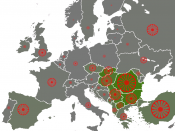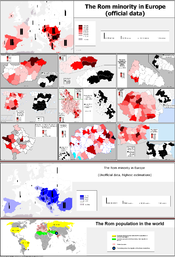The Roma have been made up of many different groups of people, and have absorbed outsiders throughout their history. Because they arrived in Europe from the East, they were thought by the first Europeans to be from Turkey, Nubia or Egypt, or any number of vaguely acknowledged non-European places, and they were called, among other things, Egyptians or 'Gyptians, which is where the word "Gypsy" comes from. In some places, this Egyptian identity was taken entirely seriously, and was no doubt borrowed by the early Roma themselves.
The Roma are a nomadic culture whose many groups travel from country to country and have no permanent home. There are more than twelve million Roma located in many countries around the world. There is no way to obtain an exact number since they are not recorded on most official census counts. Many Roma themselves do not admit to their true ethnic origins for economic and social reasons.
The Roma are a distinct ethnic minority, distinguished at least by Rom blood and the Romani, or Romanes language, whose origins began on the Indian subcontinent over one thousand years ago. No one knows for certain why the original Roma began their great wandering from India to Europe and beyond, but they have dispersed worldwide, despite persecution and oppression through the centuries.
There are four Rom "tribes", or nations, of Roma: the Kalderash, the Machavaya, the Lovari, and the Churari. Other groups include the Romanichal, the Gitanoes (Calé), the Sinti, the Rudari, the Manush, the Boyash, the Ungaritza, the Luri, the Bashaldé, the Romungro, and the Xoraxai. The first European descriptions of the Roma upon their entering Europe emphasized their dark skin and black hair; but because of integration with Europeans over the centuries, Roma today can also be found with light skin and hair.


